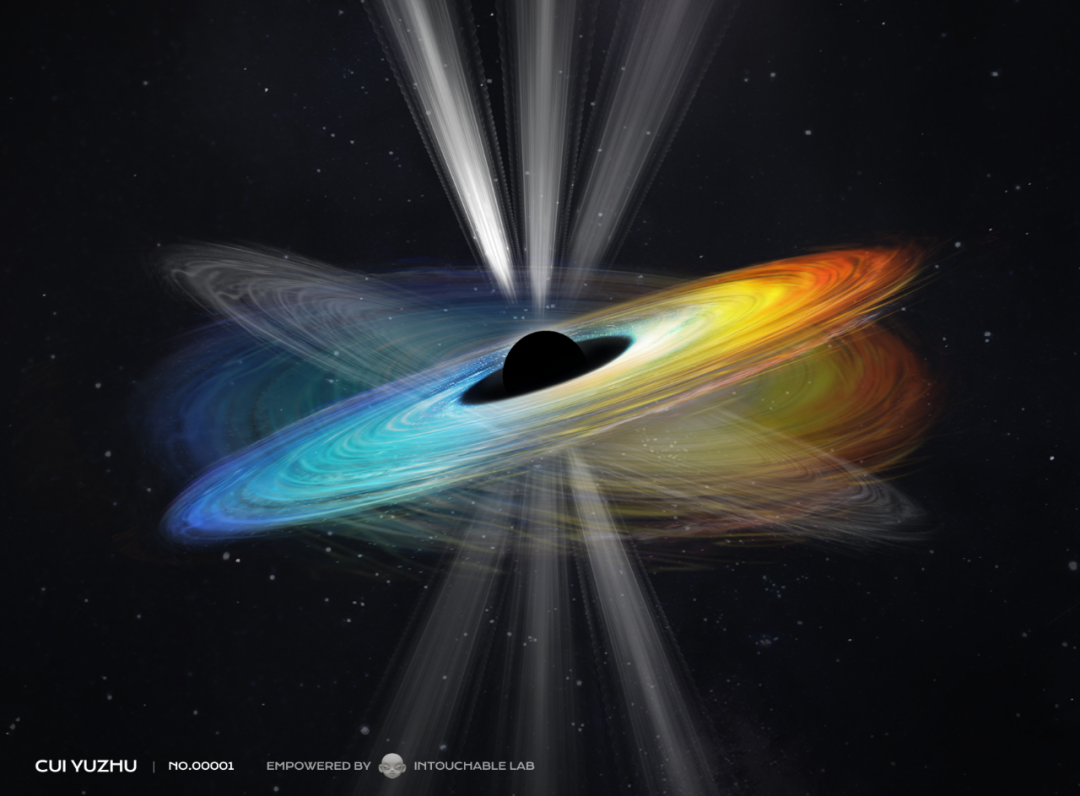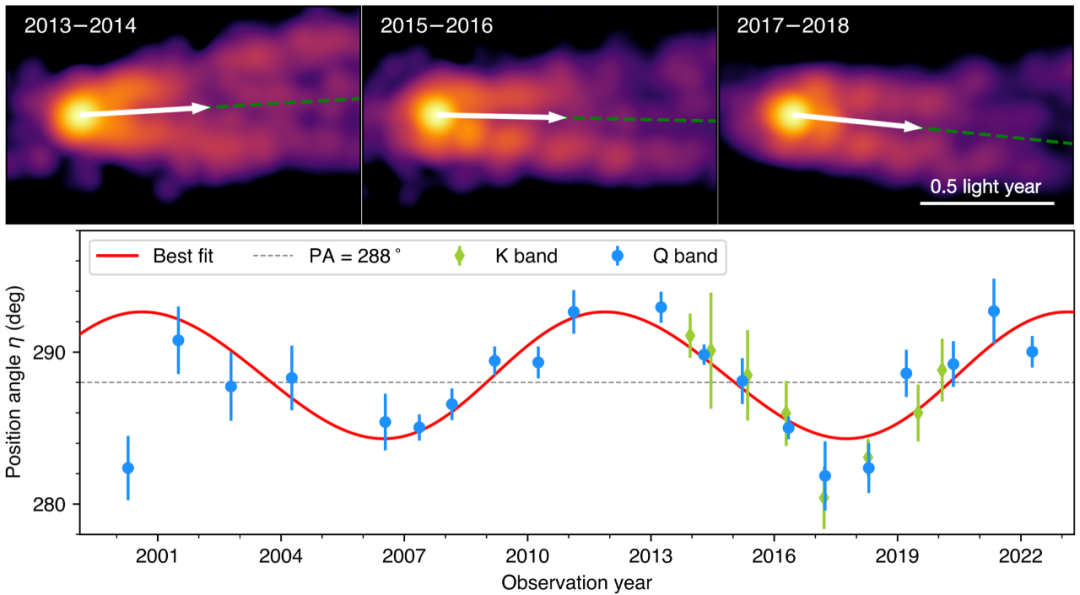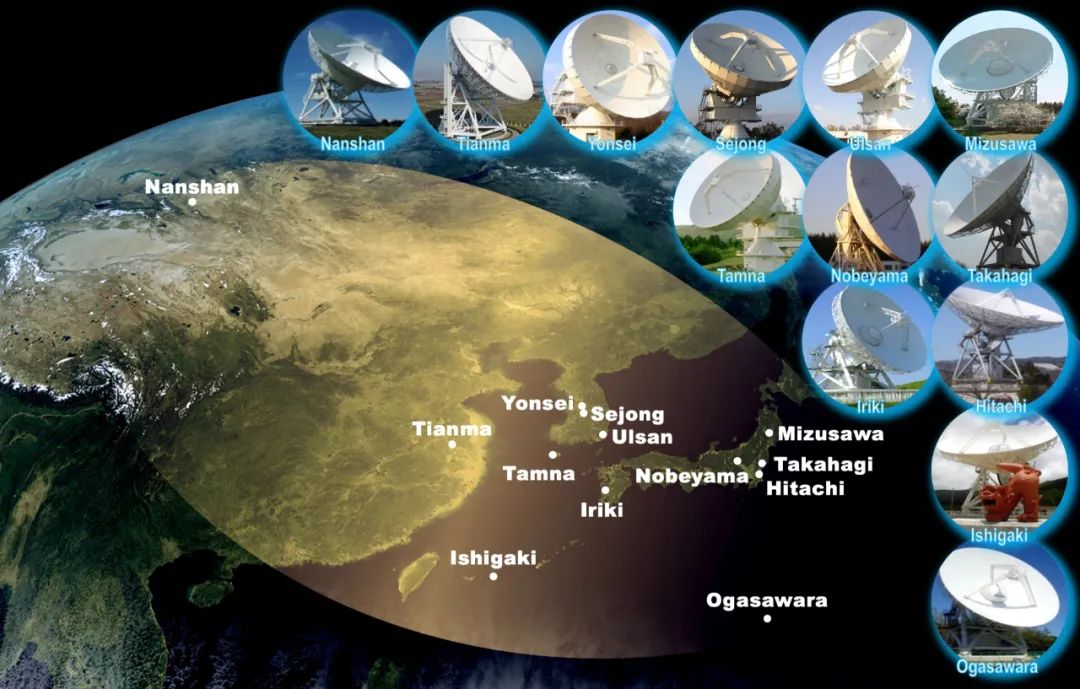
On September 27, Nature magazine released the latest research results of an international scientific research team composed of 45 institutions. By analyzing observational data from 2000 to 2022, it was found that the black hole jet at the center of the M87 galaxy exhibits a periodic swing with a swing period of about 11 years and an amplitude of about 10 degrees. This phenomenon is in line with the prediction of Einstein's general theory of relativity that "if the black hole is in a rotating state, it will cause a reference frame drag effect." This research result provides strong observational evidence for the existence of the M87 black hole spin (Figure 1). Cui Yuzhu, a postdoctoral fellow in Zhijiang Laboratory, is the first author and corresponding author of the paper.

Figure 1 Schematic diagram of the tilted accretion disk model. Assume that the spin axis of the black hole is vertically upward, the direction of the jet is almost perpendicular to the surface of the accretion disk, and there is a certain angle between the spin axis of the black hole and the rotation axis of the accretion disk, which is a tilted accretion disk model. The angle between the directions of the angular momentum of the black hole and the accretion disk triggers the precession of the accretion disk and the jet. (Source: Yuzhu Cui et al. 2023, Intouchable Lab@Openverse Hezhijiang Laboratory)
On April 10, 2019, astronomers from many places around the world simultaneously released the first photo of a black hole. It is located at the center of the nearby galaxy M87, 55 million light-years away from Earth, and is 6.5 billion times more massive than the Sun. Such supermassive black holes are one of the most mysterious and destructive objects in the universe. Their gravity is huge, and they "eat" a large amount of matter through the accretion disk. At the same time, they "spit" the matter out thousands of light-years away at a high speed close to the speed of light, forming jets.
"A strange straight ray emanated from the center of a hazy spot of light." In 1918, astronomers first observed jets in M87, the first cosmic jet observed by humans. What is the energy transfer mechanism between supermassive black holes, accretion disks and jets? This question has puzzled physicists and astronomers for more than a century.
Currently, the widely accepted theory among scientists is that the angular momentum of black holes is the source of energy. One possibility is that if there is a magnetic field near the black hole and the black hole is in a rotating state, an electric field will be generated like a conductor cutting magnetic field lines, thereby accelerating the ionized matter around the black hole, and eventually part of the matter will be ejected carrying huge energy. Among them, the spin of supermassive black holes is a key factor in this theory. However, black hole spin parameters are extremely difficult to measure, and there is still no direct observational evidence whether the black hole is in a rotating state.
To study this challenging problem, researchers studied the supermassive black hole and its jets at the center of the M87 galaxy. Using Very Long Baseline Interferometry (VLBI) with ultra-high angular resolution, astronomers have resolved the jet structure very close to the black hole. By analyzing VLBI observation data from 2000 to 2022, scientific researchers successfully captured the periodic precession of the jet in M87 (Figure 2) (Precession: a rotating rigid body caused by external force The phenomenon of rotation of its axis of rotation around a certain center).
What is the force that can regularly change the direction of this powerful jet? After extensive analysis, the research team concluded that the answer to the question may be hidden in the dynamic properties of the accretion disk. Materials with a certain angular momentum will orbit the black hole and form an accretion disk. Due to the gravity of the black hole, they will continue to approach the black hole until they are irreversibly "sucked" into the black hole. However, the angular momentum of the accretion disk can be affected by a variety of random factors, and it is very likely that it has a certain angle with the black hole's spin axis. However, the super strong gravity of the black hole will have a significant impact on the surrounding space-time, causing nearby objects to be dragged along the direction of the black hole's rotation, which is the "reference frame drag effect" predicted by Einstein's general theory of relativity, thus triggering accretion The disk and jets precess periodically.

Rewritten content: According to the research results of Yuzhu Cui et al. (2023), Figure 2 shows the merged jet structure of M87 every two years from 2013 to 2018 (observation frequency band is 43 GHz). The corresponding year is marked in the upper left corner of each subfigure. The white arrow indicates the jet position angle. The graph below is the best fit based on images merged on a one-year basis from 2000 to 2022. The green dots and blue dots represent data in the 22 GHz and 43 GHz observation frequency bands respectively. The red line represents the best fit result according to the precession model
The research team conducted a large number of detailed theoretical investigations and analyzes based on the observation results, and combined with the properties of M87, used supercomputers to conduct the latest numerical simulations. The results of numerical simulations confirm that when there is an angle between the rotation axis of the accretion disk and the spin axis of the black hole, the entire accretion disk will precess due to the drag effect of the reference frame, and the jet will also be affected by the accretion disk. Precession. Detecting the precession of the jet can provide strong observational evidence for the spin of the black hole at the center of M87, bringing new understanding of the properties of supermassive black holes.
“We are very happy and lucky to be able to make this important discovery. In 2017, when I was processing the EAVN data of the M87 galaxy, I noticed that the jet structure was significantly different from the previous direction. Since then, we began six years of detailed data processing, extensive theoretical research and Countless discussions with collaborators." As the first author and corresponding author of the paper, Cui Yuzhu, a postdoctoral fellow in the Zhijiang Laboratory, said that because the angle between the black hole spin axis and the accretion disk angular momentum is small, and the precession The cycle lasted more than ten years, accumulated 23 years of high-resolution data, and carefully analyzed the structure of M87. These are the necessary conditions for achieving this result
Cui Yuzhu We are grateful for the help and support of our many collaborators, as well as the valuable comments from the journal editors and reviewers. It is worth mentioning that one of the reviewers of our article is James Moran, a legend in the field of VLBI radio astronomy research
It is reported that this work used the East Asian VLBI Network including The global More than 20 radio telescopes contributed to the study.

Figure 3 Distribution of telescopes participating in this paper in the East Asian VLBI network (Source: Kazuhiro Hada, Yuzhu Cui et al . 2023)
Dr. Motoki Kino of Kogakuin University, Coordinator of the EAVN Scientific Working Group on Active Galactic Nuclei, said: "This is an exciting scientific milestone, thanks to Through years of joint observations by researchers from 45 institutions around the world, we have finally revealed this scientific mystery. The observational data fit perfectly with the predictions of the precession model, greatly advancing our understanding of black holes and jet systems."
"Based on this work, we predict that there are more galaxy center black holes with similar tilted accretion disk structures, but how to detect more objects with tilted disks faces greater challenges Challenges. There are still many mysteries that require more long-term observations and more detailed analysis." Researcher Shen Zhiqiang of the Shanghai Observatory of the Chinese Academy of Sciences, an important cooperating unit of this achievement, said, "The Shigatse 40-meter radio telescope of the Shanghai Observatory, which has been under construction recently, has been completed. In the future, EAVN's high-resolution millimeter-wave imaging observation capabilities will be further improved, which is expected to lead to more astronomical discoveries."
Cui Yuzhu said that the fine structure of the accretion disk and the M87 supermassive black hole The precise value of the spin still needs further study. This further research relies on the search of a very large number of physical parameters and requires the support of super intelligent computing power.
Currently, Zhijiang Laboratory has built the FAST@ZJLAB intelligent computing astronomy open platform, which brings together 17 intelligent algorithms to build BlinkVerse in fields such as fast radio bursts and astrochemistry. blinkverse.alkaidos.cn", ChemiVerse and other scientific databases, and has established a stable transmission channel with China Sky Eye FAST, and astronomical big data continues to gather.
Li Ge, chief scientist of China Sky Eye FAST and chief scientist of astronomical computing at Zhijiang Laboratory, said that as more and more radio telescopes are built, observation data will explode. is growing rapidly, so astronomical research increasingly requires the support of intelligent computing. Zhijiang Laboratory is introducing artificial intelligence, cloud computing and other technologies into astronomical research to improve data processing efficiency and expand the exploration space of physical parameters. We believe that the deep integration of computational science and radio astronomy will effectively promote the reveal of the nature of mysterious phenomena in the universe such as black holes
The above is the detailed content of In line with the predictions of general relativity, the latest research results of the M87 black hole are published in Nature. For more information, please follow other related articles on the PHP Chinese website!




